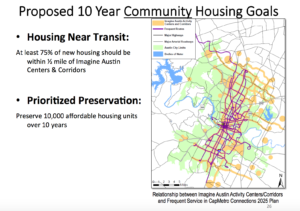Austin plan sets goals for more affordable housing. But where should it go?
Monday, April 3, 2017 by
Syeda Hasan City Council is set to vote this week on whether to adopt the city’s first-ever housing plan. The plan aims to address Austin’s growing affordability crisis by setting goals for new housing production. But apart from encouraging more affordable housing, there’s also the question of where exactly it should go.
The Strategic Housing Plan sets housing affordability goals for all 10 Council districts. Specifically, it calls for 10 percent of rental housing in each district to be affordable to households earning 30 percent or less of the median family income. For a family of four, that’s about $24,000 or less annually by 2016 measures. When it comes to home ownership, the plan calls for 25 percent of units in each district to be affordable at or below 120 percent median family income. That’s about $93,000 or less for a four-person household in 2016.
Jonathan Tomko, a senior planner with the city’s Neighborhood Housing and Community Development Office, gave a briefing on the plan at a recent meeting of the city’s Planning Commission.
“These are very aggressive goals, given that some Council districts do have a lot of affordable housing and some Council districts do not,” he said.
Location, location, location
Drilling down further, the plan calls for at least 75 percent of new housing to be located within half a mile of Imagine Austin Centers and Corridors. It also sets a goal for 90 percent of newly built or preserved affordable housing to be located within 3/4 of a mile of transit service. Commissioner Nuria Zaragoza said the district goals are an important step in addressing geographic disparities, but she noted that the most frequent transit routes and the busiest corridors are concentrated in Central and East Austin. Since the city intends to promote the majority of new affordable housing near those corridors, Central and East Austin could bear the brunt of development.

“Districts 6, 8 and 10 just don’t have the network there that the rest of the city has,” Zaragoza said. “If there’s no transit service, 90 percent is a high enough figure where it would really put those districts, in my mind, at a disadvantage.”
Zaragoza wonders how the city will draw affordable units to those West Austin districts, which also happen to be the wealthiest in the city. In much of the area, rental housing that’s affordable to people earning less than $25,000 is scarce.
“My hope is that the 90 percent will go down to something that provides more flexibility, and that we add a goal in there for high-opportunity areas that will provide that geographic dispersion that we’re all looking for and that currently does not exist,” Zaragoza said.
At last week’s Planning Commission meeting, Zaragoza also introduced an amendment to the plan to specifically look at addressing the issue of gentrification.
“It worries me that that topic is not making it to the planning documents,” she said. “Until we take it out of just community-level conversations and into planning conversations, I feel like we will never apply the social justice morals that we all know we hold as Austinites.”
Zip Codes Versus Council Districts
To promote more even dispersion, some commissioners floated the idea of setting the goals by ZIP code as opposed to Council district. But Commissioner James Shieh, who has been weighing those options since last week’s briefing, concluded that district-wide goals would allow for more meaningful, contextual planning. Shieh said ZIP codes were never meant to be used as a city-planning tool, and some of them just don’t have the capacity for added housing.
“Some ZIP codes are going to have real difficulty in doing so due to all these different regulations that are already in place,” Shieh said, “so if you set it by district, it can be thoughtful on where do you place the additional densities.”
Of course, right now most everyone is guessing at where this housing could go. The much-anticipated release of the CodeNEXT map on April 18 should provide some clarity.
The housing plan goes before Council on Thursday. If approved, it will be added as an appendix to the Imagine Austin Comprehensive Plan.
This story was produced as part of the Austin Monitor’s reporting partnership with KUT. Photo by Gabriel Cristóver Pérez/KUT News
The Austin Monitor’s work is made possible by donations from the community. Though our reporting covers donors from time to time, we are careful to keep business and editorial efforts separate while maintaining transparency. A complete list of donors is available here, and our code of ethics is explained here.
You're a community leader
And we’re honored you look to us for serious, in-depth news. You know a strong community needs local and dedicated watchdog reporting. We’re here for you and that won’t change. Now will you take the powerful next step and support our nonprofit news organization?










